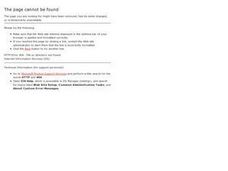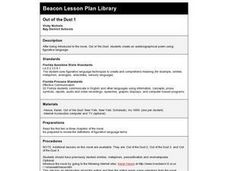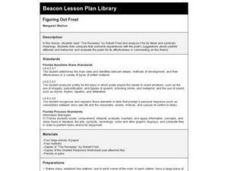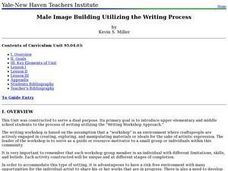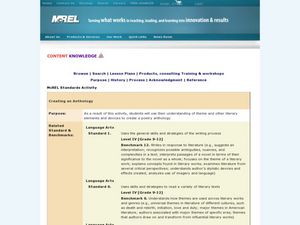Curated OER
Where's Walden and Why Henry?
Sixth graders understand how Thoreau can serve as both inspiration and model for the investigation of home places. They explore ways to become better observers of natural and cultural history. Students find out how to connect with their...
Curated OER
Ladybug Similes
In this simile activity, students review the definition and an example about similes. Students then write five similes about ladybugs, pick out the best one, and then illustrate it.
Curated OER
Discovering Ourselves in Literature and Life
Students read literature and view other media to discover how print and non-print texts answer the thematic question: Who am I? students compare the ways ideas are presented, and create their own portfolios or personal Web pages...
Curated OER
Jabberwocky-Identifying Adjectives
Elementary learners identify adjectives in sentences. They read the poem "Jabberwocky" by Lewis Carroll and highlight the adjectives. A good supplemental lesson if you are studying Lewis Carroll and/or "Jabberwocky."
Shmoop
ELA.CCSS.ELA-Literacy.RL.11-12.4
Your assessment is to figure out if I am being figurative or connotative with this statement: This is a great resource. Can’t do it? Then you had better review how to break down Common Core skill RL.11-12.4. In simple language that you...
Curated OER
A Simile and Metaphor Lesson
Students use their knowledge of similes and metaphors to analyze poetry. In this poetry and language lesson, students read examples of similes and metaphors and write their own examples that describe their city, television, or an era in...
Curated OER
Poetic Devices
For this figurative language worksheet, students read and study examples of simile and metaphor. There are 20 questions to be used with Smartboard and 10 questions in which students identify similes or metaphors.
Curated OER
Out of the Dust 1
Young scholars review figurative languages terms and examples. They read the first entry in the book, Out of the Dust, and discuss the images created by the author. Then they create an autobiographical poem using figurative language.
Curated OER
Come On, Rain!
Students read and analyze the story. In this language arts lesson, students read Come on, Rain! and examine how mood and tone are created, the use of figurative language and the characteristics of the genre. Students research the...
Curated OER
Alliterations Allowed
Fourth graders recognize and create alliterative language in both literary and commercial use. In this language arts lesson, 4th graders analyze pieces of poetry and focus on the use of imagery, personification, and figures of speech.
Curated OER
The Unraveling of a Poem
Students study poetry and poets from different countries and time periods. They analyze various poems, present a dramatic reading of a poem and teach a poem they like to their class.
Curated OER
Figuring Out Frost
Fourth graders read "The Runaway" by Robert Frost and analyze it for its literal and symbolic meanings. They compare their personal experiences with the poet's suggestions about youthful attitudes and behaviors. Some nice worksheets are...
Curated OER
Comparatively Speaking
Students practice creating similes and metaphors together as a class. Individually students create similes and metaphors and illustrate them.
Reed Novel Studies
The Shakespeare Stealer: Novel Study
Have you ever been stuck between a rock and a hard place? That is where Widge, a character of The Shakespeare Stealer, finds himself. Readers find out how Widge handles his situation by answering comprehension questions, completing...
Curated OER
Paper Cranes
Paper folding is a great art form that can be incorporated into cultural, mathematic, and art lessons. This resource includes the full instructions needed to fold a paper crane, as well as a Haiku poetry idea. Tip: This activity would be...
Curated OER
Preparing Students to Read the Aeneid
Teaching the Aeneid this year? Read this quick article to develop some plans and strategies for teaching the epic poem to your advanced learners.
Curated OER
The Stranger Redeemed: A Portrait of a Black Poet
Read and analyze poems by African-American authors. Using the text, they identify the various patterns, subjects, language and dialects used. Then team up to compare and contrast the various authors and define new vocabulary. The lesson...
Curated OER
Johnny Appleseed
Students engage in a study of apples using children's literature. They conduct research using a variety of resources. Student list facts about apples and compare them while answering some guided questions. They plant some apple seeds and...
Curated OER
Edgar Allan Poe Stories Quiz
When given a short summary of one of Edgar Allan Poe's stories, can you choose the correct title? Try your best with this multiple-choice quiz covering nine different stories (one is actually a poem) by Poe.
Curated OER
Applying SQ3R to Texts
After a review of the SQ3R strategy, readers use the provided prompts to respond to a text. The value of this worksheet is in the additional questions that move the learner into higher levels of reasoning.
Curated OER
Male Image Building Utilizing the Writing Process
Introduce your class to the techniques of proper writing. In groups, they brainstorm their ideas on family structures and discuss the importance of having a male figure in their lives. After listening to an African-American poem, they...
Curated OER
Creating an Anthology
Student compile a poetry anthology. In this literature lesson, students examine notable poetry anthologies. Students then select a theme to build their anthologies of 10 poems pertaining to their chosen theme.
Curated OER
Screening Coleridge’s Fantasies: Using Popular Music as a Bridge to Literacy
Twelfth graders use music to aid them in interpreting poetry. In this poetry lesson, 12th graders analyze the lyrics, figurative language, and literary devices of selected music. Students compare the music to the poetry of Samuel...
Curated OER
Using Rock to Teach Literary Devices: Jimi Hendrix “The Wind Cries Mary”
Students explore literary elements through music. In this figurative language lesson, students examine imagery and personification in "The Wind Cries Mary" by Jimi Hendrix.
